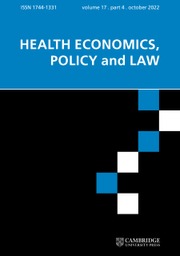The end of the year offers an opportunity to reflect on all that has happened over the past year. The year 2024, to be sure, brought many societal challenges and insecurities that also impact health systems. Climate change, workforce shortages, technological transition, and growing geopolitical tensions have significant – and largely still unknown – consequences for how we organise and provide health care at the national level, and how it impacts our thinking about (access to) care. These challenges are not only important to study and discuss as they impact health care access and quality of care, but they also mirror contemporary issues and challenges. As such, health care can act as a source or ‘site of investigation’ to study these broader societal phenomena.
For this last issue of Health Economics, Policy and Law of the year – which is published a bit later than usual – we selected articles that investigate and discuss the consequences for health and health care inequality. The papers address both broader trends, and more specific or ‘local’ challenges and uncertainties. Both are relevant to better understand our evolving health systems and concerns now, and in the future.
One of those bigger challenges is the United Nations' Sustainable Development Goals, among others to provide universal health coverage by 2030. Watson and Amin (Reference Watson and Amin2024) study the availability of care in Canadian regions, monitoring the number of physicians (‘labour capacity’) and beds (‘capital’). They demonstrate the regional differences in both labour and capital that account for one-third of the efficiency cap between city regions and rural areas. They argue for more specific policies to overcome regional disparities and enhance universal access. The United Nations sustainability goals are also addressed by Singh (Reference Singh2024), who examines the impact of publicly funded health insurance on health care demand. Based on a quasi-experimental study addressing hysterectomy (removal of the uterus) among women in India, they find that public-funded health insurance coverage increases the change of this surgical intervention instead of ensuing preventative or primary care. These findings signal an urgent need to study the (perverse) effects of the aim of universal health coverage, and how this goal gets institutionally embedded in evolving health systems. In the third paper, Dixon et al. (Reference Dixon, Horton, Newman, McDermott and Lucassen2024) discuss the impact of genomics and genetic information on risk-based insurance and related regulatory models in the UK. Evolving technologies and knowledge related to genetic information provides challenges to risk-based insurance as risks can be better predicted yet remain ‘risks’ and hence do not tame uncertainty. However, they also increase insecurity by bringing in new types of uncertainty, prompting new regulatory issues. Authors suggest a deliberative approach to establish when and how genetic information can be used in risk-rated insurance. The role of health insurance is further elaborated on by McFarland and Miller (Reference McFarland and Miller2024), who ‘test’ Bedford's law to study how health care finance impact clinical decision making and influence health care costs. Although Bedford's law points to a logarithmic distribution of clinical encounters and treatment, the authors show that expenditures unexpectantly increase in case of more severe conditions, also for non-clinical activities, indicating inefficient health care expenditure. This is particularly the case among self-insured patients. The article by Hassoun et al. (Reference Hassoun, Basu and Gostin2024) shifts focus to the issue of pandemic preparedness. Authors propose a renewed ‘Access to Pandemic Tools Accelerator’, adding the pillars of economic assistance and structural inequalities for future pandemic preparedness and response. More specifically, they introduce the ‘Pandemic Open Technology Access Accelerator’ (POTAX) to provide conditional financing for new vaccines and other essential health technologies and pooled intellectual property and other data necessary to allow equitable access to the resulting technologies. The authors argue that the proposed model will support collective procurement and measures to enhance equitable distribution and uptake of technologies, leveraging a more equal distribution of preparedness. The article by Van de Sande et al. (Reference van de Sande, de Graaff, Delnoij and de Bont2024) draws attention to the regulatory perspective of health care access and quality control. Based on a Q-methodological study of the role and position of a regulatory agency in the Netherlands, they reveal the convergent and sometimes conflicting expectations that regulatory agencies must deal with to meet public expectations. The final article of this issue, authored by Daniels et al. (Reference Daniels, Marneffe and Bielen2024), addresses the issue of technology, studying doctor–patient communication concerning medical incidents through virtual reality. The virtual reality application allows them to investigate whether physicians' verbal communication about a medical incident impacts patients' perceptions and willingness to (legally) hold the physician accountable for the caused harm. Contrary to earlier research, they find that open communication renders patients more willing to take measures, like contacting a lawyer about possible actions. The authors argue that this may be due to the fact physicians put more emphasis on their own (wrongful) actions than the physicians acting more defensively (and pointing out patients' wrongdoings). Moreover, the article shed light on how technology plays a role in investigating health care provision.
This last issue of the year provides in-depth insights into some pressing challenges of our times. In the coming year(s) we will further draw attention to and seek to gain evidence in the politics of changing health care systems and point out some important underlying trends and topics that will be discussed through perspective pieces, special issues, and regular articles. Among others, topics that will be addressed are the increasing privatisation and financialisation of health care systems, health care workforce and planetary crisis, health care coverage, and the growing role of populism in contemporary health care systems and practices. We invite scholars interested in health system policy and politics to submit papers and respond to publications to evoke and pursue academic and policy debates, to eventually contribute to more sustainable health systems and health care worldwide.



